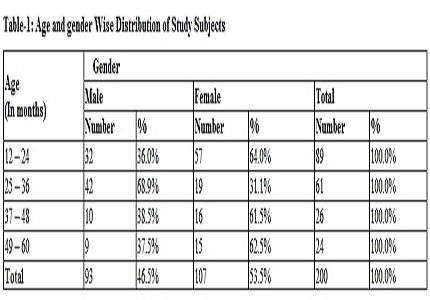Frequency of urinary tract infection in febrile children of one to five years of age
Abstract
Introduction: Fever is the most common reason for children 1-5 years of age to visit Emergency / out patient departments. Little attention has been focused on the identification of urinary tract infections in febrile children, despite recent information that suggests a high prevalence of urinary tract infections and significant associated morbidity in these patients. This study is undertaken to determine the prevalence of urinary tract infection in febrile children one year to five years of age and to evaluate various diagnostic methods for a case of Urinary tract infection.
Method: Febrile children (rectal ≥38.3˚C or auxiliary temperature ≥37.8˚C) of 1 to 5 years of age were studied over a period of 12 months February 2015 to January 2016 at our tertiary care centre. History and relevant investigations were done.
Result: The study included 200 children. The overall prevalence rate of urinary tract infection in the present study was 5.5% with prevalence in children 1-2 years of age 2%. 13.5% of cases showed significant pyuria. Among pyuric patients 40.74% were culture positive with a M:F of 1.2:6. USG done in significant pyuric cases revealed renal involvement /anomaly in 6 cases.
Conclusion: Clinicians should consider obtaining a urine specimen as part of their diagnostic evaluation as urinary tract infection is a possibility in febrile children. Pyuria of ≥ 5 pus cells /HPF in centrifuged sample should be considered as significant pyuria and further evaluation should be done promptly to initiate treatment and to prevent morbidity and long term sequalae.
Downloads
References
2. Mårild S, Jodal U. Incidence rate of first-time symptomatic urinary tract infection in children under 6 years of age. Acta Paediatr. 1998 May;87(5):549-52. [PubMed]
3. Pecile P, Miorin E, Romanello C,Vidal E, Contardo M, Valent F et al.Age-related renal parenchymal lesions in children with first febrile urinary tract infections. Pediatrics 2009 Jul;124(1):23-9. doi: 10.1542/peds.2008-1192.
4. Shaikh N, Ewing AL, Bhatnagar S, Hoberman A. Risk of renal scarring in children with a first urinary tract infection: a systematic review. Pediatrics. 2010 Dec;126(6):1084-91. doi: 10.1542/peds.2010-0685. Epub 2010 Nov 8.
5. Hudson RG. Lessons from the guidelines: understanding evidence-based vesicoureteral reflux treatment in 2010. Dialogues in Pediatric Urology 2011;32:5-6.
6. Rushton HG, Majd M, Jantausch B, Wiedermann BL, Belman AB. Renal scarring following reflux and non reflux pyelonephritis in children: evaluation with 99m technetium-dimercaptosuccinic acid scintigraphy. J Urol. 1992 May;147(5):1327-32. [PubMed]
7. Berg UB. Long-term follow up of renal morphology and function in children with recurrent pyelonephritis. J Urol. 1992 Nov;148(5 Pt 2):1715-20. [PubMed]
8. Jacobson SH, Eklöf O, Eriksson CG, Lins LE, Tidgren B, Winberg J. Development of hypertension and uraemia after pyelonephritis in childhood: 27 year follow up. BMJ. 1989 Sep 16;299(6701):703-6. [PubMed]
9. Saadeh SA, Mattoo TK, Managing urinary tract infections. Pediatr Nephrol. 2011 Nov;26(11):1967-76. doi: 10.1007/s00467-011-1801-5. Epub 2011 Mar 16. [PubMed]
10.Hoberman A, Charron M, Hickey RW, Baskin M, Kearney DH, Wald ER. Imaging studies after a first febrile urinary tract infection in young children. N Engl J Med. 2003 Jan 16;348(3):195-202. [PubMed]
11. Roberts KB, Charney E, Sweren RJ, Ahonkhai VI, Bergman DA, Coulter MP, Fendrick GM, Lachman BS, Lawless MR, Pantell RH, et al. Urinary tract infection in infants with unexplained fever: a collaborative study. J Pediatr. 1983 Dec;103(6):864-7. [PubMed]
12. Fallahzadeh MH, Alamdarlu HM. Prevalence of urinary tract infection in pre-school febrile children. Iranian J of Med Sci 1999; 24: 35-9.
13. Shaikh N, Morone NE, Bost JE, Farrell MH. Prevalence of urinary tract infection in childhood: a meta-analysis. Pediatr Infect Dis J. 2008 Apr;27(4):302-8. doi: 10.1097/INF.0b013e31815e4122. [PubMed]
14.Bauchner H, Philipp B, Dashefsky B, Klein JO. Prevalence of bacteriuria in febrile children. Pediatr Infect Dis J. 1987 Mar;6(3):239-42. [PubMed]
15.Srivaths PR, Rath B, Prakash SK, Talukdar B. Usefulness of screening febrile infants for urinary tract infection. Indian Pediatr. 1996 Mar;33(3):218-20. [PubMed]
16. Jack S. Elder: Urologic disorders in infants and children. Richard E Behrman, Kliegman RM, Stanton BF,(19th eds): Nelson textbook of Pediatrics, Elsevier and Saunders 2011 p p. 1827-1864. [PubMed]
17. Jaya G, Bal CS, Padhy AK, Bandopadhyaya GP, Pattnayak SK, Malathi KE. Radionuclide studies in the evaluation of urinary tract infections. Indian Pediatr. 1996 Aug;33(8):635-40. [PubMed]
18. Bryan CS, Reynolds KL. Hospital acquired Bacteremic urinary tract infection: Epidemiology and Outcome. J Urol. 1984 Sep;132(3):494-8.
19. BaggaA, Sharma J. Urinary tract infections clinical features, evaluation and treatment. Pediatr today 2000; 3: 395-401.
20. Bell LE, Mattoo TK. Update on childhood urinary tract infection and vesicoureteral reflux. Semin Nephrol. 2009 Jul;29(4):349-59. doi: 10.1016/j.semnephrol.2009.03.011. [PubMed]
21. Bensman A, Dunand O, Ulinski T. Urinary Tract Infection. In : Avner ED, Harmon WE, Niaudet P, Yoshikawa N, eds, pediatric nephrology Berlin; Springer – Verlag; 2009.pp 1299-310. [PubMed]
22. Akram M, Shahid M, Khan AU. Etiology and antibiotic resistance patterns of community-acquired urinary tract infections in J N M C Hospital Aligarh, India.Annals of Clinical Microbiology and Antimicrobials 2007;6:4. doi:10.1186/1476-0711-6-4. [PubMed]
23. Copp HL, Shapiro DJ, Hersh AL. National ambulatory antibiotic prescribing patterns for pediatric urinary tract infection, 1998-2007. Pediatrics. 2011 Jun;127(6):1027-33. doi: 10.1542/peds.2010-3465. Epub 2011 May 9. [PubMed]
24. Dahle KW, Korgenski EK, Hersh AL, Srivastava R, Gesteland PH. Clinical Value of an Ambulatory-Based Antibiogram for Uropathogens in Children. J Pediatric Infect Dis Soc. 2012 Dec;1(4):333-6. doi: 10.1093/jpids/pis055. Epub 2012 Jun 29. [PubMed]

Copyright (c) 2016 Author (s). Published by Siddharth Health Research and Social Welfare Society

This work is licensed under a Creative Commons Attribution 4.0 International License.


 OAI - Open Archives Initiative
OAI - Open Archives Initiative


